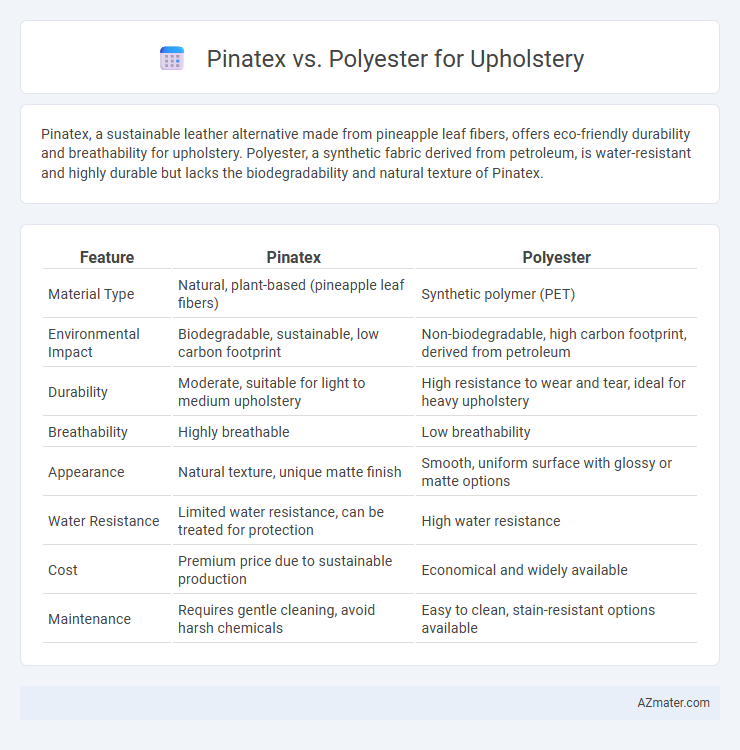Pinatex, a sustainable leather alternative made from pineapple leaf fibers, offers eco-friendly durability and breathability for upholstery. Polyester, a synthetic fabric derived from petroleum, is water-resistant and highly durable but lacks the biodegradability and natural texture of Pinatex.
Table of Comparison
| Feature | Pinatex | Polyester |
|---|---|---|
| Material Type | Natural, plant-based (pineapple leaf fibers) | Synthetic polymer (PET) |
| Environmental Impact | Biodegradable, sustainable, low carbon footprint | Non-biodegradable, high carbon footprint, derived from petroleum |
| Durability | Moderate, suitable for light to medium upholstery | High resistance to wear and tear, ideal for heavy upholstery |
| Breathability | Highly breathable | Low breathability |
| Appearance | Natural texture, unique matte finish | Smooth, uniform surface with glossy or matte options |
| Water Resistance | Limited water resistance, can be treated for protection | High water resistance |
| Cost | Premium price due to sustainable production | Economical and widely available |
| Maintenance | Requires gentle cleaning, avoid harsh chemicals | Easy to clean, stain-resistant options available |
Introduction to Piñatex and Polyester Upholstery
Pinatex, a natural textile made from pineapple leaf fibers, offers an eco-friendly alternative to traditional upholstery materials with its sustainable sourcing and biodegradable properties. Polyester, a synthetic fiber derived from petrochemicals, is widely used in upholstery for its durability, stain resistance, and cost-effectiveness. Comparing Pinatex and polyester highlights the trade-offs between environmental impact and performance in furniture upholstery applications.
Material Origins and Production Processes
Pinatex, derived from pineapple leaf fibers, offers a sustainable alternative to traditional upholstery materials by utilizing agricultural waste and requiring minimal water and chemical inputs during production. Polyester, a synthetic fiber made from petroleum-based polymers, involves energy-intensive manufacturing processes with significant environmental impact due to fossil fuel extraction and non-biodegradability. The natural origin and eco-friendly production of Pinatex contribute to reduced carbon footprint and waste compared to the petrochemical-dependent origins and synthetic processing of polyester upholstery.
Environmental Impact and Sustainability
Pinatex, derived from pineapple leaf fibers, offers a biodegradable and renewable alternative to traditional upholstery materials, significantly reducing environmental pollution and waste compared to polyester. Polyester, a synthetic polymer made from petroleum, contributes to microplastic pollution and relies on non-renewable resources, causing higher carbon emissions throughout its production lifecycle. Choosing Pinatex supports sustainable agriculture and circular economy principles, making it an eco-friendly textile choice in comparison to petroleum-based polyester.
Durability and Longevity Comparison
Pinatex, made from pineapple leaf fibers, offers natural durability with a tensile strength comparable to synthetic polyester, making it resistant to wear and tear in upholstery applications. Polyester, known for its high abrasion resistance and colorfastness, generally outperforms Pinatex in longevity under heavy use but lacks the sustainable benefits of plant-based materials. While Pinatex provides eco-friendly resilience suitable for moderate use, polyester remains the preferred choice for long-lasting upholstery where maximum durability is critical.
Comfort and Texture Differences
Pinatex, derived from pineapple leaf fibers, offers a natural, breathable texture that enhances upholstery comfort by promoting airflow and reducing heat retention. Polyester upholstery, made from synthetic fibers, tends to be less breathable but provides a smooth, consistent texture with high durability and stain resistance. The choice between Pinatex and polyester significantly impacts comfort levels, with Pinatex favoring a more eco-friendly and breathable experience, while polyester excels in resilience and ease of maintenance.
Maintenance and Cleaning Requirements
Pinatex upholstery requires gentle cleaning with a damp cloth and mild soap, as it is made from natural pineapple leaf fibers that can be sensitive to harsh chemicals and excessive moisture. Polyester upholstery offers higher durability and stain resistance, allowing for more aggressive cleaning methods, including machine washing and commercial cleaners. Regular maintenance for Pinatex involves avoiding prolonged exposure to direct sunlight and moisture to prevent fading and degradation, while polyester resists fading and moisture damage more effectively, making it a low-maintenance choice.
Color, Style, and Design Versatility
Pinatex offers a natural, matte finish with earthy tones and subtle texture variations, making it ideal for eco-conscious upholstery designs seeking organic style and understated elegance. Polyester provides a broad spectrum of vibrant colors and patterns, delivering exceptional design versatility and durability suitable for bold, contemporary interiors. Both materials cater to diverse aesthetic preferences, with Pinatex emphasizing sustainability and unique texture, while polyester excels in color range and ease of customization.
Cost Analysis: Piñatex vs Polyester
Pinatex upholstery typically costs between $30 to $60 per yard, reflecting its sustainable, plant-based origin and artisanal production methods. Polyester fabric ranges from $5 to $20 per yard, making it a more budget-friendly option for large-scale or high-traffic upholstery projects. The higher upfront cost of Pinatex is often justified by its eco-friendly benefits and unique texture, while polyester offers durability and stain resistance at a lower price point.
Applications in Modern Upholstery
Pinatex, derived from pineapple leaf fibers, offers a sustainable and breathable alternative to traditional polyester upholstery, enhancing eco-friendly furniture design. Polyester, known for its durability and stain resistance, remains popular in high-traffic commercial applications due to its easy maintenance and cost-effectiveness. Modern upholstery increasingly favors Pinatex for luxury and sustainable interiors, while polyester continues to dominate in budget-friendly and high-performance settings.
Conclusion: Choosing the Right Upholstery Material
Pinatex offers a sustainable, eco-friendly alternative to traditional polyester upholstery, providing natural breathability and unique texture derived from pineapple leaf fibers. Polyester remains popular for its durability, stain resistance, and cost-effectiveness, making it suitable for high-traffic areas. Selecting the right upholstery material depends on prioritizing environmental impact versus performance and budget considerations.

Infographic: Piñatex vs Polyester for Upholstery
 azmater.com
azmater.com